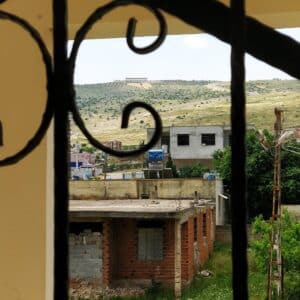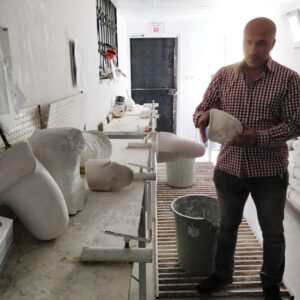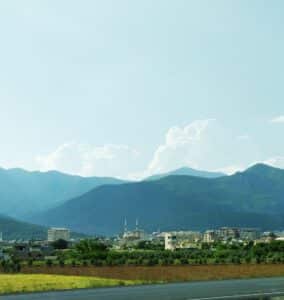
The view of the Turkey Syrian border from the prosthetic limb clinic
In early May, three of us went to the Turkish border with Syria, to meet with some of the people who run our projects on the ground. At the moment, we are supporting a Primary Health Clinic, a Prosthetic Limb Clinic and a Medical Training project as well as (at the time ) an education project. The value of placing ourselves in front of people who know the daily context inside Syria is unquestionable. Any detachment felt as a result of distance or inexperience is removed by a conversation which directly relays the reality of those who provide and receive the aid on the ground.
This was most apparent on our visit to the Reyhanli Prosthetic Limb Clinic, run by our partner, Syria Relief. At four years, it is the longest project we have supported to date. You might imagine time could reduce the impact of seeing the clinic and its patients. The thing is though, that each individual you meet sticks with you, as do their stories.
One patient we met at the clinic was a nine year old Syrian girl called Rana, accompanied by her father and sister. All three had piercing and bright blue eyes, distracting enough to make the tied-up jeans on Rana’s left leg not immediately noticeable. She and her younger sister sat chatting in Arabic to one another, while we were told Rana’s story. The family were from Eastern Ghouta originally. When Rana was three, she was playing in the street with a cousin, when a car bomb detonated next to them. She lost her left leg below the knee, and her right leg was damaged so much that it is unusable. Since then, the family has sought a viable prosthesis, but has found them either too expensive or too painful for Rana to wear because of the cheap quality of materials used. Hearing her story and the clinic’s plans for a new prosthesis, which would allow her to walk for the first time in six years, conveyed a devastating but inspiring combination of need, urgency, resilience and hope.

The workshop at the clinic, where the casts for the prosthetic limbs are made
Our meetings with colleagues from other partners continued this theme, leaving us awed by their tenacity in continuing despite the overwhelming challenges facing them; whether financial or life-threatening. As a small charity, we have the privilege of working very closely with our partners, and we know them well. Following this trip, as always, our respect and understanding of them and their work has increased; whether the efficiency of those running the primary health clinics or the raw emotional investment in their beneficiaries of those running schools in besieged norther Homs. This is why, beyond due diligence on the partners and projects we fund, actually visiting the clinics and the people running them has such great value. It opens us completely to the human side of the money we send and allows us to relay this back to our donors.

The countryside on the approach to the border
Simply put, we cannot be detached from the real, human suffering of these people, and the unwavering determination of the doctors and teachers to relieve it. In spite of the shattering conflict, millions of Syrians continue to survive daily. They need resources, they need treatment and they need aid. One of the many obstacles to that is increasing fatigue and detachment from donors. The former medical officer for Aleppo told us that this time last year 55% of the required aid budget in the north west had been funded. This year, only 5% has been promised.
It is so important to that we do not forget Syria and the need of its people. Only by the generosity and incredible efforts of people like you are we able to keep supporting them. Please don’t let Syria fade from your mind – by doing so, you might just save someone like Rana’s life.
Or buy tickets to a Syrian Supper Club here

Keeping supporters clued up on our work is important to us. Sign up to keep up to date with where the funds go and the impact they have, and how you can support us.